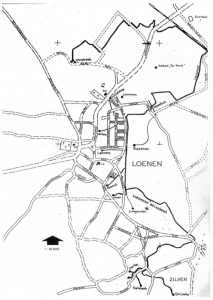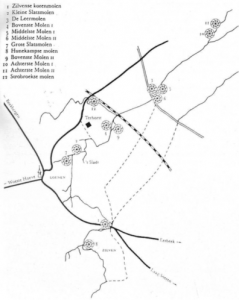The Hunekamp
The laundry The Hunekamp is already more than a century drawn to this place, since 1894, to be precise; the year A.J. Aarnink here started his laundry business. Like many laundries in the Veluwe, De Hunekamp before that time a paper mill. That mill was already there since 1666 and was owned by Allard Hackfort, Mr Kasteel ter Horst.
Aarnink hammered the waterwheel on two sides and formed close it that way for a giant drum. Through a hatch on the side could was charged and this will be removed. From 1908 the natural driving force of the sprinkle stream was replaced by a steam engine. In 1919, the laundry went up in flames. The following year, a new building was erected.
Currently the Hunekamp is a business center for technology. The building is due to its cultural and historical value and because of its striking roof construction on the monument of the municipality of Apeldoorn.
Agricultural development
In the southeast of the city of Apeldoorn is the village of Loenen. It forms an integral whole with the hamlets Zilven and Veldhuizen, respectively, on the south and north of the village. The corresponding area is bordered by the English Channel Apeldoorns on the northeast side of the city limits on the east side and a strip enkenlandschap and Loenen Serbian Forest on the south and west.
The earliest mention of “Lona” and “Sulvenda ‘originates from 838. Both are flankesdorpen, originated in the early Middle Ages on the eastern flank of the Veluwe Moraine. Initially Loenen and Zilven consisted of groups of farms around greens on the road from Beekbergen to Eerbeek. The other buildings lay scattered on the enken. The fields were bordered by a wild excavation, a wall of oak which arable land protected against wild. When the need for increased arable land, were constructed outside the game Count fields. South of Zilven identified are parts of the game count in the landscape. Western and southern van Loenen and Zilven is additionally a large part of the enkwal, with a low coppice-covered shore, which probably took over the function of the game count. The convex shape of the enken itself mainly west of the village, south of the Vrijenbergweg and in the vicinity of the Dutch Reformed Church north of Loenen yet extremely recognizable.
On the east side of the settlements were located low and wet marshlands. When the emphasis in the agricultural sector at the end of the nineteenth century shifted from agriculture to livestock, low pastures and hayfields were more accessible and drained, so that could be used and occupied the eastern region. At that time, also came to Veldhuizen development. The now redundant moors and sand drifts were trees on the west side. In nature the Loenermark and in Loenen Serbian Forest are still remnants of the heath and sand drifts present. The village Loenen lost its agricultural character and got the function of a residential area.
Agricultural lands were managed jointly by the Loener- and Silver Mark, like the moors, forests and marshlands. In the management of the Silver Mark well Huyningk played a central role in the Loenermark farm Horst. The family Hackfort, who later lived in Huis Ter Horst, took over that responsibility. They also were the initiators of the construction of a chapel in 1557, later Dutch Reformed Church. The family converted castle Ter Horst and practiced in many ways influence on the development of Loenen.
Sprinkles, De Molenbeek and the Paper Industry
Loenen is common for welbronnen; places at the foot of the Veluwe where water often invisible emerges. Loenen more than twelve of these seepage springs were discovered and used to lead the water through ditches to a stream. The locks are known as sprinkle the seepage sources sprinkle heads. Brooks and sprinkle were initially indispensable for the water management of the agricultural area. From the seventeenth century, then they were an important source of power for the burgeoning paper industry. In 1647 Loenen had nine paper mills. Initially fell water supply (and therefore the sprinkle) under the responsibility of the Marches, which granted licenses to their graves. From this organizational model functioned a number of sprinkle independently of each other. When the water right into the hands of the Barons of Hackfort castle ter Horst, the various sprinkle were led to the Molenbeek, which was dug in the first half of the seventeenth century. Molenbeek eventually flows through Klarenbeek and Supporters in the IJssel.
De Vrijenbergerspreng, on the northwest side of Loenen, was dug about 1869 to the Apeldoorn Canal (also) to maintain. The bowls rises in the forests of Schalter, has a waterfall of about fifteen meters and consists of two parts, the Free Berger Spreng and Veldhuizerschool Spreng, each of which is approximately six kilometers long.
Along the streams and dug sprinkle resurrected countless water mills, some of which still exist and are absorbed in a number of cases in subsequent paper or paperboard. The Hunekampsmolen and the Middle Mill are still recognizable as water mills, thanks to their strong relationship with the corresponding streams and sprinkle. even the Middle Mill still works and has a museum function. The Hind Mill has become a cardboard factory. The Straw Broekmolen been converted into apartments.
The Loenense Molenbeek
Until today, the Loenense Molenbeek jointly owned by three companies at the brook ‘established, namely Hunekamp, SolidPack and Smurfit Kappa. The maintenance of the Loenense Molenbeek in the management of the Regional Water Valley and Veluwe.


 Deutsch
Deutsch Nederlands
Nederlands
